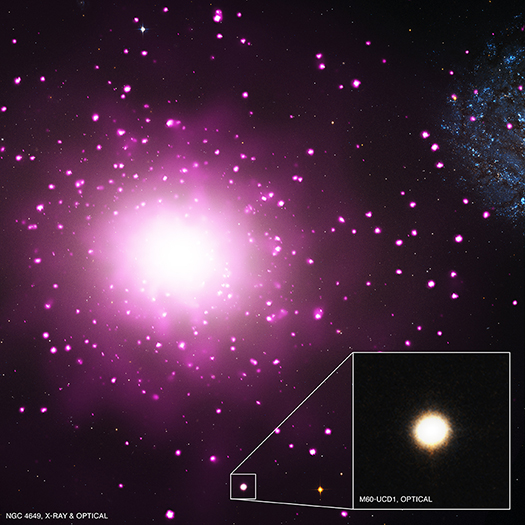Smithsonian Astrophysical Observatory
Weekly Science Update | 2013 Sep 13
Our nearest neighbor star, Proxima Centauri, is about 4.2 light-years away. This distance is typical (on average) between stars (or gravitationally bound stellar systems) in the Milky Way and similar galaxies. In terms of density, there are about 0.02 stars per cubic light-year in the general neighborhood of the Sun. At the other extreme of stellar density, a globular cluster - a spherical collection of as many as a million stars orbiting a galaxy - can have an average of over ten stars per cubic light-year, and even higher densities near its center. Astronomers are trying to understand what limits the density of stellar neighborhoods, if and how the average densities differ in different sized galaxies, and the relationship of stellar densities to the sizes of the supermassive black holes at galaxy centers.
- A Hubble image of the central region of the galaxy M60, showing at its outskirts the small dwarf galaxy M60-UDC1 (inside the red circle). This dwarf is found to be the galaxy with the highest known density of stars (a more typical dwarf galaxy is shown inside the dotted red circle. The diagonal white streak is an artifact). (Credit: NASA/HST; J. Strader)
A dwarf galaxy is small in both size and mass, with 100-1000 times fewer stars than the Milky Way. Astronomers interested in stellar densities are naturally curious about the densities in such small systems. CfA astronomers Pepi Fabbiano and Nelson Caldwell and their colleagues spotted a strange dwarf galaxy on the outskirts of a much larger galaxy, Messier 60, about sixty million light-years away (that is, in our cosmic vicinity). This dwarf is only about 80 light-years in radius (compared with our Milky Way's radius of tens of thousands of light-years), but the scientists determined that it has a stellar mass of density of over one hundred stars per cubic light-year, making it the densest known galaxy.
The astronomers used the Chandra X-ray Observatory to reveal an X-ray source at the dwarf galaxy's center. The source could be either a nuclear supermassive black hole or perhaps a pair of binary stars emitting X-rays - additional observations are needed to resolve the issue. The authors point out that if the central object is a nuclear black hole, it is likely that this dwarf galaxy was once a much larger galaxy that collided with another galaxy. It was stripped of most of its matter in the interaction but its nucleus, left relatively unaffected, remained behind to consolidate the remnants into the dense system seen today. While it is always fascinating to discover new extrema in the cosmic zoo, these results also shed light on processes that affect galaxy evolution and the properties of dense stellar systems.
The Densest Galaxy - Jay Strader et al
- Astrophysical Journal Letters 775(1) L6 (2013 Sep 20) DOI: 10.1088/2041-8205/775/1/L6
arXiv.org > astro-ph > arXiv:1307.7707 > 29 Jul 2013 (v1), 14 Aug 2013 (v2)
<< Previous Science Update


